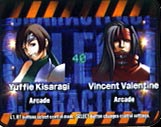 The last few months have been
slow for new fighting games, but the release of SquareSoft's Ehrgeiz signals the end of
the drought. Tons of fighting games are being released in the next few months (check out ) and Ehrgeiz is one of
the titles with the most game for your dollar. Ehrgeiz is hardly just a fighting game. It
includes a standard 3D fighting game (arcade mode, versus, and practice), as well as a
surprisingly large and involved role playing game, and four mini-games. As a fighting game
alone Ehrgeiz is pretty flat and fast moving, but with some fatal flaws. The whole Ehrgeiz
game, on the other hand, is pretty damned fantastic.
The last few months have been
slow for new fighting games, but the release of SquareSoft's Ehrgeiz signals the end of
the drought. Tons of fighting games are being released in the next few months (check out ) and Ehrgeiz is one of
the titles with the most game for your dollar. Ehrgeiz is hardly just a fighting game. It
includes a standard 3D fighting game (arcade mode, versus, and practice), as well as a
surprisingly large and involved role playing game, and four mini-games. As a fighting game
alone Ehrgeiz is pretty flat and fast moving, but with some fatal flaws. The whole Ehrgeiz
game, on the other hand, is pretty damned fantastic.
Ehrgeiz Official Fighter's Guide
by David Cassady
Brady Games
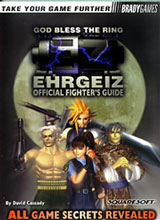
We picked up a copy of the Ehrgeiz Official Fighter's Guide from Brady Games, figuring
that if any game was big enough to need a whole book about it, Ehrgeiz is the one. The
multiple modes and the mini games make for a package that is dense and complicated. The
Fighter's Guide can be useful for mastering the game in a short time.
The guide covers all the aspects of the game. It gives backstory on each of the
characters, even the hidden ones, as well as a complete listing of moves. There are
pictures of the moves in-progress, so you can really tell whether or not you're pulling
off the right one. It's easy to learn the moves for all of the characters in the game,
especially since the control combinations are virtually identical for each character, but
that's not the strategy guide's fault. The guide is also hindered because so many of
Ehrgeiz's complex moves require such precise timing, and no book can teach you that.
The instructions for the various game modes are handy. With the breadth that Ehrgeiz
has, the instruction manual just isn't enough. The guide goes so far as to provide useful
hints for how to play each mode. While it doesn't cover any cheats or codes, there are
ways to level up in quest mode quickly and other useful strategies. The objects, food, and
deities of the quest mode are listed in huge charts with handy statistics. The charts are
great when playing through the complex RPG embedded in Ehrgeiz.
While everything that is in the Official Fighter's Guide is quality information and
very useful, there are still areas that are undercovered. There are no screen caps of the
quest mode, and that is a noticeable flaw. Not only are some of the graphics fun to look
at, but some of the menu screens are complex. Granted, they are fairly well explained in
the instruction manual, but it would be nice to have all of the information in one place.
The guide seems to make a defense of this, noting that the dungeons in each quest are
randomly generated, but there aren't even pictures of monsters, the town, or the bosses.
The minigames are also glossed over, and could benefit from more in-depth coverage. The
guide mentions that defeating the CPU at Battle Panel ten times in a row will make Evil
Panel available, but does not give any description at all of the extra mode. Also, neither
the guide nor the instruction manual mention what it means in Battle Panel when it puts up
the "Hint" message.
Overall, the Official Fighter's Guide can be handy if you have an extra $12 to drop on
mastering Ehrgeiz. It is better to have a nicely manufactured guide available, rather than
a printout of an ascii text walkthrough. The Fighter's Guide will also help you get better
at Ehrgeiz more quickly by using the strategies and charts included. |
The Ehrgeiz fighting game is unique; it only uses five buttons: high attack, low
attack, special attack, jump and guard--but simple it is not. Fighting gets technical with
grabs, throws, interrupts, counters, just techniques, and special attacks. The fighting is
a little too complicated for my tastes. Don't get me wrong, I love Tekken 3 as much as
anyone with its vast amount of moves and complex combos, but the problem with Ehrgeiz's
fighting lies in the tricky timing required to get any complex move off. Any move with a
"step" in it must be done with the directional pad and not the analog, the same
with any precision jumping. This wouldn't be a problem if the directional pad allowed for
the same quick movement in the 3D environments as the analog.
The environments are possibly the best thing about the fighting game; most have
multiple levels allowing the characters to jump to higher ground during the battle. Some
are large and some are very small; I could never get the hang of fighting on the train
because the area was so restricted.
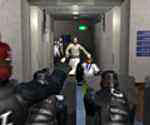 Ehrgeiz also
offers another option that makes the fighting much more interesting: boxes. On most levels
there are two boxes, and the boxes can be slid at your opponent to do some damage. But,
more importantly, busting them open reveals health and special attack power-ups and
special weapons. The environments and boxes are pretty nifty features, but I think that
Power Stone on the Dreamcast has the same features done better.
Ehrgeiz also
offers another option that makes the fighting much more interesting: boxes. On most levels
there are two boxes, and the boxes can be slid at your opponent to do some damage. But,
more importantly, busting them open reveals health and special attack power-ups and
special weapons. The environments and boxes are pretty nifty features, but I think that
Power Stone on the Dreamcast has the same features done better.
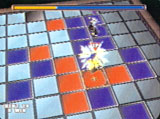 It is not the fighting that makes Ehrgeiz a four star game; it's all of the
Ehrgeiz's games together. The RPG Quest mode alone is worth playing. It has one town and
21 randomly generated levels of dungeons. You play one of two characters (if one of them
dies you can continue your quest with the other): Koji, a professor and three time Ehrgeiz
fighting champ, and Clair, an ultra-talented 16 year old university student. They also
reappear as hidden characters in the fighting game. You travel the levels from the top
dungeon down while fighting lots of monsters, increasing levels, gaining magic, weapons,
and eating. The town and dungeons are simple, but have an in-depth character management
system. Your character has hit points as well as a hunger meter that decreases as you move
around, and more as you're fighting. Food is even more complicated. You need to eat a
balanced diet: vitamins, minerals, lipids, carbohydrates and the rest. Food can be found
in the dungeons – that is, if you don't mind eating monster meat and mushrooms. In
the town you can buy more delicious fare like ice cream and watermelon.
It is not the fighting that makes Ehrgeiz a four star game; it's all of the
Ehrgeiz's games together. The RPG Quest mode alone is worth playing. It has one town and
21 randomly generated levels of dungeons. You play one of two characters (if one of them
dies you can continue your quest with the other): Koji, a professor and three time Ehrgeiz
fighting champ, and Clair, an ultra-talented 16 year old university student. They also
reappear as hidden characters in the fighting game. You travel the levels from the top
dungeon down while fighting lots of monsters, increasing levels, gaining magic, weapons,
and eating. The town and dungeons are simple, but have an in-depth character management
system. Your character has hit points as well as a hunger meter that decreases as you move
around, and more as you're fighting. Food is even more complicated. You need to eat a
balanced diet: vitamins, minerals, lipids, carbohydrates and the rest. Food can be found
in the dungeons – that is, if you don't mind eating monster meat and mushrooms. In
the town you can buy more delicious fare like ice cream and watermelon.
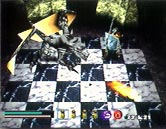 If you can't
tell, I really got a kick out of this aspect of the game. The armor and weapon systems are
quite involved; both break and decrease in effectiveness as you use them. By bribing the
blacksmith with liquor you can have him repair and combine equipment. On all the even
levels of the dungeon there are altars, and by leaving offerings to certain gods you can
have yourself or your equipment enchanted, increasing stats and levels. This RPG within a
fighting game also has it's own mini-game, a stock market wine trading game. It almost
seems like a waste to have such an intricate method of play and only 21 semi-mundane
levels of dungeon. I'm kind of hoping that SquareSoft might be testing out this game play,
and if they get the right feed back they'll develop a full game out of it (I know I'm
dreaming, but a girl has got to have dreams).
If you can't
tell, I really got a kick out of this aspect of the game. The armor and weapon systems are
quite involved; both break and decrease in effectiveness as you use them. By bribing the
blacksmith with liquor you can have him repair and combine equipment. On all the even
levels of the dungeon there are altars, and by leaving offerings to certain gods you can
have yourself or your equipment enchanted, increasing stats and levels. This RPG within a
fighting game also has it's own mini-game, a stock market wine trading game. It almost
seems like a waste to have such an intricate method of play and only 21 semi-mundane
levels of dungeon. I'm kind of hoping that SquareSoft might be testing out this game play,
and if they get the right feed back they'll develop a full game out of it (I know I'm
dreaming, but a girl has got to have dreams).
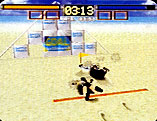 The fighting game is all right, the quest mode is great, but what about the
mini-games? Shawn and I found Battle Panel, an othello/go type of board game, highly
addictive. You pick characters from the fighting game and run around the board trying to
make all the squares your color. It's more interesting than the original board games
because you play simultaneously and can even tackle each other to prevent your opponent
from getting a key square before you do. There are 3 other mini-games: the Infinity
Battle, just like survival mode on Tekken 3, Beach Battle, a race game like the
thumb-numbing Track and Field on the NES, and Battle Runner, which is a lot like roller
derby without the roller skates and much more fighting. Most of the mini-games are as much
fun as the fighting game and provide a change of pace without changing the disk.
The fighting game is all right, the quest mode is great, but what about the
mini-games? Shawn and I found Battle Panel, an othello/go type of board game, highly
addictive. You pick characters from the fighting game and run around the board trying to
make all the squares your color. It's more interesting than the original board games
because you play simultaneously and can even tackle each other to prevent your opponent
from getting a key square before you do. There are 3 other mini-games: the Infinity
Battle, just like survival mode on Tekken 3, Beach Battle, a race game like the
thumb-numbing Track and Field on the NES, and Battle Runner, which is a lot like roller
derby without the roller skates and much more fighting. Most of the mini-games are as much
fun as the fighting game and provide a change of pace without changing the disk.
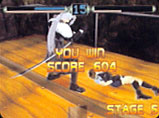 Throughout, Ehrgeiz suffers from a 16-bit musical score. Whether SquareSoft did
this to harken back to the "good old days" of gaming is not clear, but it's
obnoxious nonetheless. The plot line, both in Quest Mode and the fighting game, is barely
there, which didn't help me make sense of the fairly dull and obtuse winning FMVs.
Indicative of the poorly shaped plotline, there are characters from Final Fantasy VII
thrown in for giggles. Their presence is unaccounted for. I could buy them as hidden
characters, but, as they are available from the gitgo, it's just a blatant attempt at
selling more copies by using recognizable characters who may or may not fit the game.
These aspects, coupled with the questionable control, make Ehrgeiz a game with some real
downfalls. SquareSoft succeeded in packing Ehrgeiz with as much variety as is possible,
but in order to attain that level of variety they sacrificed some finishing elements. All
of the various modes and games and mini games suffer from graphics that are just shy of
optimal, playing areas that are not quite as large or interactive as comparable games, and
a general sense of mediocrity. Fortunately, the piling of so many different play options
lends a sort of gestalt to the title as a whole.
Throughout, Ehrgeiz suffers from a 16-bit musical score. Whether SquareSoft did
this to harken back to the "good old days" of gaming is not clear, but it's
obnoxious nonetheless. The plot line, both in Quest Mode and the fighting game, is barely
there, which didn't help me make sense of the fairly dull and obtuse winning FMVs.
Indicative of the poorly shaped plotline, there are characters from Final Fantasy VII
thrown in for giggles. Their presence is unaccounted for. I could buy them as hidden
characters, but, as they are available from the gitgo, it's just a blatant attempt at
selling more copies by using recognizable characters who may or may not fit the game.
These aspects, coupled with the questionable control, make Ehrgeiz a game with some real
downfalls. SquareSoft succeeded in packing Ehrgeiz with as much variety as is possible,
but in order to attain that level of variety they sacrificed some finishing elements. All
of the various modes and games and mini games suffer from graphics that are just shy of
optimal, playing areas that are not quite as large or interactive as comparable games, and
a general sense of mediocrity. Fortunately, the piling of so many different play options
lends a sort of gestalt to the title as a whole.
Ehrgeiz has found a home in my Playstation, and even a few months from now I can
imagine myself have an insatiable need to play some battle panel. While it has its flaws,
Ehrgeiz manages to overcome them to succeed with it's variety. The next time you go to the
store looking for a game and can't decide if you want a RPG or a fighting game or just
something fun, remember Ehrgeiz has it all as long as you don't mind an amicable
compromise.

 The last few months have been
slow for new fighting games, but the release of SquareSoft's Ehrgeiz signals the end of
the drought. Tons of fighting games are being released in the next few months (check out ) and Ehrgeiz is one of
the titles with the most game for your dollar. Ehrgeiz is hardly just a fighting game. It
includes a standard 3D fighting game (arcade mode, versus, and practice), as well as a
surprisingly large and involved role playing game, and four mini-games. As a fighting game
alone Ehrgeiz is pretty flat and fast moving, but with some fatal flaws. The whole Ehrgeiz
game, on the other hand, is pretty damned fantastic.
The last few months have been
slow for new fighting games, but the release of SquareSoft's Ehrgeiz signals the end of
the drought. Tons of fighting games are being released in the next few months (check out ) and Ehrgeiz is one of
the titles with the most game for your dollar. Ehrgeiz is hardly just a fighting game. It
includes a standard 3D fighting game (arcade mode, versus, and practice), as well as a
surprisingly large and involved role playing game, and four mini-games. As a fighting game
alone Ehrgeiz is pretty flat and fast moving, but with some fatal flaws. The whole Ehrgeiz
game, on the other hand, is pretty damned fantastic.